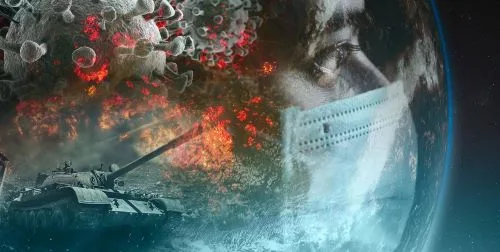What is the Milk Warning Us About?
H5N1 in dairy cattle is a wake-up call to CSOs. COVID may feel over, but new disruptive biosecurity threats are constantly emerging. Last week, we told you the milk isn’t the threat—it’s the warning. If H5N1 evolves dangerously, the CSO role will once again be responsible for the company response plan, but the knock-on effects of biosecurity threats can be hard to anticipate. This week, we walk you through three possible and highly disruptive H5N1 scenarios: the agricultural disaster, the moderate pandemic, and the severe pandemic. These scenarios are valuable for shaping preparedness strategies and highlighting biologically possible outcomes but are not intended as near-term predictions.
Scenario #1 Massive Agricultural Disruption
In Scenario #1, H5N1 evolves to massively disrupt agriculture by causing severe disease in dairy or beef cattle or by asymptomatically infecting humans who could unintentionally spread the virus throughout commodity operations (cattle or poultry). The consequences of an H5N1-driven catastrophic agricultural disease would be extensive. Initially, commodity prices would rise dramatically; those costs would then ripple through the US economy. The food industry, grocery stores, restaurants, and anywhere serving food (including public schools and hospitals) would feel the brunt of food scarcity and high prices. How would your food services team adapt? Will there be cost overruns?

A devastating agricultural H5N1 would trigger an international response. Although World Trade Organization member countries are required to justify trade restrictions due to disease, fear could trigger highly reactive import bans. Even if the World Organization for Animal Health (the designated adjudicator of animal disease-related embargos) eventually found import restrictions could not be justified, the impact on U.S. markets would be massive. Agriculture, food, and related industries contribute 5.6% of the US GDP and employ 10.4% of US workers. 2023 US export values included $9.97B (beef), $8.01B (dairy), $5.49B (poultry), and $760M (eggs).
Scenario #2 A Moderate Pandemic – H1N1 Redux
In Scenario #2, H5N1 acquires the ability to be transmitted between people. Influenza viruses have two protein spikes on their outer layer: the H in H5 and the N in N1. Pandemic influenza viruses have novel spike proteins that our immune systems haven’t seen before. That universal lack of past exposure through infection and vaccine means essentially all people are susceptible to the new virus. Current seasonal influenza vaccines cover an H3N2 and an H1N1 (along with two influenza B viruses); the H5 would be entirely new.
Pandemic severity reflects the transmissibility and severity of illness. In Scenario #2, H5N1 would echo the 2009-2010 H1N1 swine flu pandemic, which was moderately infectious and moderately severe. To imagine the company impacts of this scenario, CSOs can review the impacts that moderate biosecurity threats (e.g., H1N1 or Zika) had on their operations and assess what new options exist today. Key questions include:
- What departments or roles had the greatest excess absenteeism or reduced productivity? What were the challenges faced in 2009-2010, and were they fully addressed during COVID-19, or do you need to find solutions? Where hybrid isn’t an option, did reduced customer demand match absenteeism impacts?
- Did your business host flu vaccine clinics onsite to lower barriers to employees getting the extra flu shot? H1N1 got a separate vaccine from seasonal flu that year. The same thing could happen if H5N1 evolves. Reducing infections can limit productivity losses, reduce absenteeism, and save on health insurance premiums.
- Are your business continuity plans up to date, to include lessons learned? Do they reflect the current organizational structure and identify the correct decision makers?

Scenario #3 A Severe Pandemic – H5N1 Goes Person-to-Person and Regains Previous Severity
In this darkest scenario, a severe H5N1 pandemic spreads easily between people and regularly causes severe disease. An earlier strain of H5N1 killed about 50% of identified human cases. Even if H5N1 didn’t kill half of the people infected, a plausible worst-case scenario could see rates much higher than the 8.7% case fatality rate that COVID averaged in studies conducted during the first year of the pandemic. This severe influenza pandemic would be COVID on steroids.
No pandemic looks exactly like the previous pandemic, but the experience of decision makers can be invaluable in tackling a new crisis. Before staff turnover cements a complete loss of institutional knowledge, CSOs should document not just the decisions made during past pandemics but also the challenges and the considerations. A playbook that dictates if X then Y will rapidly fall short. Instead, CSOs should record the decision-making processes, criteria, considerations, and ripple effects. Lessons learned should not focus on the specific tactical solution selected but rather on how leaders successfully understood the problem and strategically planned for it.
Waiting to develop a plan is too risky for today’s conditions. These scenarios require thoughtful consideration and planning to ensure your business weathers any possible disruption. PHC Global understands businesses need early warning on both tactical and strategic intelligence. We combine expertise, data, and technology to give you the insight you need now to ensure business continuity.
Sign up for a free trial of PHC Pharos today and equip your business with the tools needed for an ever-changing world, so you can protect your people, assets and revenue.


